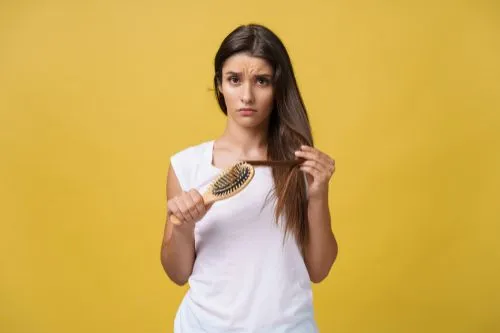Hair loss can impact confidence, with women often experiencing isolation and depression as they tend to keep their struggles private, unlike men who are more open to seeking help for hair loss.
Hair loss is prevalent among women, with over 50% experiencing it at some stage in life and a striking 80% affected by age 80. The leading cause is female pattern hair loss, known as androgenetic alopecia, impacting approximately 30 million women in the U.S.
Hair loss is a prevalent issue among females, with over 50% experiencing it at some stage in their lives and a staggering 80% affected by the age of 80. The primary culprit behind this is female pattern hair loss, also known as androgenetic alopecia, which impacts approximately 30 million women in the United States.
How Does Female Hair Loss Differ from Male Hair Loss
Female hair loss differs from male hair loss in several key ways. While both conditions may involve androgenetic alopecia, commonly known as pattern baldness, the presentation and progression of hair loss vary between genders.
In men, hair loss typically follows a well-defined pattern characterized by a receding hairline and thinning at the crown, resulting in a distinct “M” shape. Over time, this may progress to partial or complete baldness.
On the other hand, female hair loss tends to manifest as overall thinning rather than distinct patterns. Women generally do not experience significant hairline recession, and complete baldness is less common. Instead, the hair becomes thinner throughout the scalp, often retaining the natural hairline.
Understanding these differences is crucial in diagnosing and addressing hair loss effectively in both men and women.
Why Am I Losing My Hair?
As women age, they undergo changes in their androgen levels, which are sex hormones crucial for growth, reproduction, and hair growth regulation. These hormonal shifts can cause hair follicles to shrink over time, resulting in shorter, finer hair strands and eventual cessation of hair growth in affected areas. Paradoxically, some women may experience increased hair growth in other body regions, like the face or chin, due to variations in androgen receptor distribution across different body areas.
In some cases, female pattern hair loss can be caused by:
Several factors contribute to female hair loss, including genetics, medications, surgeries, health conditions, and hormonal changes. Genetic predisposition, especially from maternal relatives, increases the risk of female pattern baldness. Certain medications like blood pressure or gout medicines, as well as high doses of vitamin A, can also trigger hair loss. Surgeries causing physical stress may lead to hair loss. Health conditions such as polycystic ovary syndrome, thyroid disease, precocious puberty, and anemia can be underlying causes. Hormonal fluctuations due to pregnancy, menopause, or birth control pills may also play a role. It’s crucial to consult a doctor if experiencing symptoms like scalp rash, redness, pain, hair breakage, patchy hair loss, or unusual patterns, as they could indicate a more severe condition.
How Can I Treat Female Hair Loss?
Treatment for female hair loss involves various strategies to manage the condition and promote hair growth. While hereditary hair loss may be inevitable, lifestyle adjustments such as avoiding smoking, controlling vitamin A intake, limiting sun exposure, and maintaining a nutritious diet supplemented with biotin can help reduce risk factors. Consulting a doctor, who may refer you to a dermatologist specialized in hair loss, is advisable if experiencing female pattern hair loss. Dermatologists may recommend treatments ranging from over-the-counter options like minoxidil to prescription medications such as finasteride, platelet-rich plasma therapy, or hair transplant surgery, depending on individual symptoms and needs.
Addressing female hair loss is essential for both physical and emotional well-being, as it can significantly impact self-confidence and identity. Despite the stigma surrounding women’s hair loss, seeking professional help from a dermatologist is crucial. Understanding the causes and recognizing the signs enable access to various treatment options, including topical solutions like minoxidil, hormone-blocking medications, platelet-rich plasma therapy, or hair transplants. Taking proactive steps with medical guidance can restore not only hair but also confidence and self-esteem. It’s important not to hesitate and to reach out to a healthcare professional to reclaim a fuller, healthier mane.
Schedule a appointment today with Dermatologist in Chatsworth.


